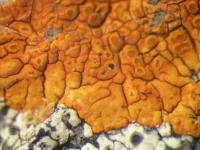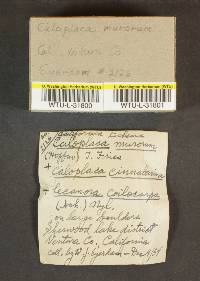
Consortium of Lichen Herbaria
- building a Global Consortium of Bryophytes and Lichens as keystones of cryptobiotic communities -
- Home
- Search
- Images
- Species Checklists
- US States: O-Z >
- US National Parks
- Central America
- South America
- US National Parks
- Southern Subpolar Region
|
|
|
|
Family: Teloschistaceae
[Blastenia cinnabarina (Ach.) Lindau, moreBrownliella cinnabarina (Ach.) S.Y. Kondr., Kärnefelt, A. Thell, Elix, Jung Kim, A.S. Kondr. & Hur, Callopisma cinnabarinum (Ach.) Müll.Arg., Callopisma cinnabarinum var. opacum Müll.Arg., Caloplaca cinnabarina var. opaca (Müll.Arg.) Zahlbr., Lecanora cinnabarina Ach., Parmelia cinnabarina (Ach.) Spreng., Placodium cinnabarinum (Ach.) Nyl., Urceolaria tessellata Taylor] |
Nash, T.H., Ryan, B.D., Gries, C., Bungartz, F., (eds.) 2007. Lichen Flora of the Greater Sonoran Desert Region. Vol 3. Life habit: lichenized Thallus: crustose, areolate, margin abrupt at edge or slightly lobed or notched, without elongated lobes; prothallus: absent surface: orange, smooth, without asexual propagules cortex: cellular, 14-28 µm thick, granules absent; medulla dense Apothecia: immersed, 0.1-0.4 mm in diam., lecanorine disc: orange, flat, epruinose margin: disappearing, flush; thalline margin present; proper margin not visible parathecium: cellular (paraplectenchymatous); exciple below hypothecium amorphous epihymenium: golden, K+ red, H-, 10%N-, cN-, C- hymenium: hyaline 40-55 µm tall paraphyses: not swollen or 1-2 tip cells slightly swollen, not branched or with few branches; subhymenium hyaline asci: cylindrical, 8-spored ascospores: hyaline, 2 locules, ellipsoid, 8.5-11 x c. 4 µm, isthmus c. 3 µm, spore end wall thin Pycnidia: present, totally immersed, ostiole orange Spot tests: apothecial margin K+ red; thallus K+ red, H-, 10%N-, cN-, C- Secondary metabolites: parietin, fallacinal, emodin, teloschistin, and parietinic acid. Substrate and ecology: on non-calcareous rocks World distribution: worldwide Sonoran distribution: Arizona, Baja California Sur, western Chihuahua, Sonora, and northern Sinaloa. Notes: The name Caloplaca cinnabarina has been used incorrectly in North America for species of the C. squamosa group for over 100 years. The C. squamosa group has an areolate to subsquamulose thallus. The most obvious difference between C. cinnabarina and C. rubelliana is the color of the apothecial discs. Caloplaca rubelliana has a scarlet red disc and more grayish thallus while the C. cinnabarina has more orange discs and much more brightly orange thalli. Another difference is in the thallus margin. Caloplaca rubelliana has thallus edges that gradually taper off to nothing or to some prothallus:, while C. cinnabarina has a distinct, abrupt edge without thinning. Both species have slightly elongated areoles at the margins as opposed to C. rosei that has no elongated areoles at the margins and is strictly a maritime species. |
|
|
|
Powered by Symbiota































































































